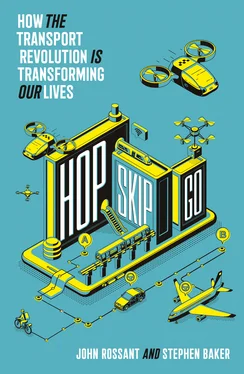But Czinger’s Webvan experience might tamp down a bit of the giddiness. There’s a point in every boom, he knows, when markets turn from wonder to skepticism. This usually occurs after an early highflier goes bust, which leads investors to start asking hard questions about revenue and profits.
As pretenders fail, investors retreat and survivors feast on the fallen, picking up their code, their brainpower, their customers. In the aftermath, giants emerge. We cannot say at this point—no one can—where the companies we’re getting to know, including Divergent 3D, will end up in this food chain. But whether they emerge as champions or fall and get swallowed along the way, they’re busy building the next generation of mobility. Their workers and the code they write, and the industrial process they create, will play a part of this revolution, no matter which competitors emerge on top.
This was true for Webvan as well. The company was investing mightily, its monthly expenses dwarfing revenue. Profits, if they ever arrived, were years away. By the time the market’s mood changed, in the spring of the year 2000, and investors’ gazes turned from soaring visions to the bottom line, Webvan might as well have worn a sign around its neck saying SHOOT ME. The company’s funding dried up, and it declared bankruptcy in 2002. Amazon, the survivor, promptly pounced on Webvan’s assets, including its warehouses. That giant got bigger. “The core team up at Amazon,” Czinger says, “is the old Webvan team, from robotics to warehousing.” He and his team lost control, but fed the ecosystem.
Nonetheless, Kevin Czinger managed not only to escape this Darwinian drama, but to walk away a rich man. He had managed to vest rich options while Webvan’s stock soared. He subsequently added to his wealth with lucrative stints in private equity.
So in 2008, not yet fifty years old, Kevin Czinger decided to do something big. His goal was nothing less than to save the world from global warming, while at the same time returning to his lifelong passion for cars. So he cofounded an electric car company, Coda Automotive. Most of his investors came from China, and the venture targeted the Chinese market.
As it turned out, Coda released its only model, an electric sedan, in 2012—the same year that Tesla came out with its hit luxury car, the Model S. The Tesla bested Coda in crucial categories, including range, and trounced it in the marketplace. That spelled Coda’s doom. Within a year, Czinger was shoved out, and Coda was seeking bankruptcy protection. Now having succumbed to two iconic companies, Amazon and Tesla, Kevin Czinger was plotting his next move.
Even before Coda’s fall, he says, he realized that his push for affordable electric cars was foolish—or at least dangerously misinformed. He had believed, like millions of electric car drivers today, that shifting the auto industry to an electric fleet would help save humanity from overheating our planet and killing ourselves. The cars don’t pollute. They don’t even have tailpipes .
But in 2009, Czinger came across a document that changed his thinking: a five-hundred-page report, Hidden Costs of Energy , produced by the National Academy of Sciences. It introduced the concept of life-cycle analysis and convinced Czinger that his entire vision (and those of other electric car companies, including Tesla) had everything backward.
Cars begin polluting, the report argued, long before a new owner presses the accelerator for the first time. It detailed the immense energy consumed in manufacturing a vehicle. This consumption starts with iron miners digging deep into the earth, hauling up mountains of ore, and loading them onto trains or barges. They transport it usually hundreds of miles, which consumes more energy. In steel mills, iron pellets fired with hard coal, called coke, are smelted in roaring blast furnaces that reach nearly 3,000 degrees Fahrenheit. The molten iron ore flows into other furnaces, where it’s refined into thick slabs of steel, which are pressed by massive rolling pins and eventually flattened into sheets. Then the gleaming rolls of steel are shipped off to an auto plant. Each step of this process burns lots of fuel, in turn spewing metric tons of greenhouse gases into the atmosphere.
The other materials arriving at the same auto plant’s docks—the plastics, glass, and chemicals—each emerge from their own industrial processes, most of them involving fires and furnaces. The manufacturing of a car, according to the report, consumes more energy and creates more earth-warming havoc than the actual car will produce as it plies the streets and highways for a decade or two. As Czinger read the report, it became clear to him that practically any new car, even an electricity-fueled Leaf or Tesla, was an environmental liability. “I was such a dummy,” he says.
But this revelation led Kevin Czinger toward yet another staggeringly ambitious goal: This time, instead of feeding the world or electrifying transportation, he would take it upon himself to dramatically clean up auto manufacturing. And as if that weren’t enough, he also aimed to minimize the environmental damage that cars create once they’re built. This is where, a decade earlier, he had held out hope for emission-free electric cars. But the simple laws of physics overturned this logic. If you’ve ever tried pushing a car, you know that budging even a smallish one, a Mini Cooper, say, or a Camry, requires loads of energy (and a strong back). Compared with those cars, Tesla’s luxury Model S, the one that sank Coda, was a behemoth. The first prototype, displayed in 2009, weighed in at 4,600 pounds. About one-quarter of that weight came from the battery alone. Moving millions of them would require countless gigawatts.
Even without an internal combustion engine, and absent the fumes, those gigawatts had to come from somewhere . About two-thirds of the electricity in the world, Czinger saw, came from burning fossil fuels. This added to global warming. Sure, there were promising trends. Norway’s electrical grid was fueled by alternative energy. California was quickly making strides in that direction. Electricity in France came mostly from nuclear plants, which despite other concerns produce no greenhouse gases. But most of the world’s electricity came from carbon, and it would for decades. Using that electricity to move heavy vehicles hundreds of billions of miles, Czinger realized, was unsustainable.
What’s more, the world’s biggest and fastest-growing car market—China—promised unmitigated disaster. Most of China’s electric cars, in effect, would be running on filthy coal . This promised some relief for the coughing and wheezing masses in smoggy Beijing and Shanghai. But from a global perspective, it simply shifted the pollution from crowded cities to the distant fossil fuel–burning utilities elsewhere. For the future of the planet, it was even worse. “Turning China’s fleet to electric cars,” he says, shaking his head, “is the most insane thing you could ever think of doing.”
So Kevin Czinger would not only clean up the industrial process. His manufacturing system would also produce dramatically lighter cars. At one-third the weight of traditional cars, they would consume less energy, regardless of the engine type. That would result in cleaner air.
His goal was to replicate the cyclical patterns and feedback loops of nature. This is a recurring theme throughout the mobility world, and indeed, in the broader sphere of computing. The idea is that throughout our industrial history, we have been starved of vital information, or feedback. Most traffic lights at four thirty a.m. don’t see that we’re waiting at the corner all alone. They cannot adjust to changing conditions, as a crossing guard might, and wave us through. Lacking this data, they blindly rely on programmed rules. On an intelligence scale, they’re somewhere between rocks and refrigerators—unresponsive, but reliable. Entire industries, as we’ll see, are focused on seeding elements of the physical world, including traffic lights, with sensors, and turning the dumb machines into adaptive networks, ones that behave more like plants and animals.
Читать дальше












